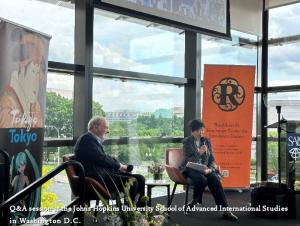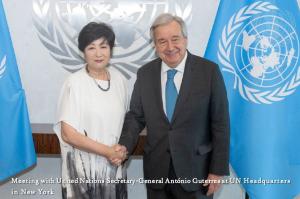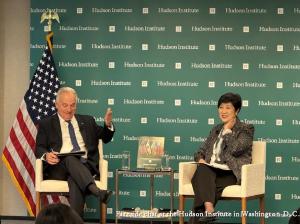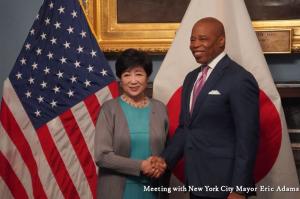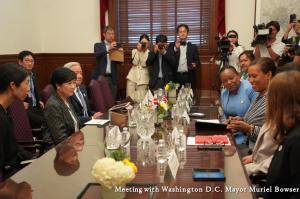TOKYO, JAPAN, September 18, 2025 /EINPresswire.com/ -- Tokyo Governor Koike Yuriko has called on cities around the world to unite in tackling common urban issues, especially disaster resilience. Her proposal comes at a time when national governments face trade and other multilateral challenges.
Delivering this message at every stop, she toured Washington, D.C., and New York City for lectures and other engagements in late July. The governor advocated “multi-city lateralism,” a term she has coined from “multilateralism,” an established concept of coordination among nations to achieve common goals.
Governor Koike—a former member of parliament elected in 2016 as Tokyo’s first-ever female chief executive—also used the opportunity to promote her capital city’s presence on the world stage. She suggested Tokyo could host some operations of the United Nations, which is celebrating its 80th anniversary this year.
And, as a model for multi-city cooperation, Governor Koike presented the international forum of cities on common challenges, named the Global City Network for Sustainability (G-NETS), which has been organized by the Tokyo Metropolitan Government since 2022. The governor said she intends to revamp this network to strengthen the collaboration of cities in their efforts against climate change and disasters.
“In these turbulent times, nations often find themselves with conflicting interests stalling multilateralism efforts,” she told a high-level panel discussion at the United Nations Economic and Social Council on July 24. “And when it comes to urban management, cities cannot stand by when lives and homes are lost to floods.”
The governor said multilateralism has been constrained amid “heightened global uncertainties.” She cited pandemics, regional conflicts in the Middle East and Ukraine, and economic tensions, notably recent tariffs, among the contributing reasons.
During her six-day stay in the U.S. megaregion, Governor Koike also spoke at the non-profit thinktank Hudson Institute and the Johns Hopkins University School of Advanced International Studies in Washington D.C. on July 21.
At these forums, the governor highlighted the Tokyo 2050 Strategy, which her administration put forth in March packing policies to be implemented by 2035 to realize the “Vision” of what Tokyo aims to be in the 2050s. It spans a wide spectrum including childcare, women's empowerment, and urban resilience. “We are committed to a change. We are committed to making Tokyo the best city in the world,” she said.
Tokyo Ready to Host a UN Office with ‘Safety, Security and Other Advantages’
In her meeting with UN Secretary General António Guterres on July 24, the governor suggested Tokyo, one of the world’s largest and most vibrant cities, could host some functions of the cost-strapped world body. Japan has already been hosting the UN University in Tokyo for 50 years and remains a major financial contributor to the UN budget and agencies.
“I think he is familiar with the safety, security and other advantageous aspects of living (in Tokyo) now including the weak yen,” she told reporters after meeting Mr. Guterres at the UN Headquarters. The UN chief replied that he has received similar offers of cooperation from across the world, the governor said.
Governor Koike, a well-known newscaster in her youth, told the Hudson Institute forum that inviting global organizations is a “prime opportunity for Japan to regain its prominent position on the world stage.”
Establishing a multinational institution will “draw the international community's attention to East Asia, and this will ultimately demonstrate Japan's commitment to freedom or order during this time of the fragmentation.”
Cities Focus on ‘People in Front of Us’ – Not Trade or Tariffs
Stressing the importance of the multi-city alliance, she said in a speech at Hudson Institute that multinational discussions remain focused on trade negotiations including tariffs “rather than addressing the pressing needs of our communities.” “Cities can engage in dialogue and practical cooperation without falling into geopolitical rivalries by focusing on the people in front of us.”
However, Governor Koike—who served as Japan’s first female defense minister in 2007 after heading the environmental ministry 2003-2006—admitted that states still play a “significant role particularly in terms of security.”
At Johns Hopkins graduate school, she elaborated on Tokyo’s readiness to lead global cooperation in resilience efforts through the international forum of cities, G-NETS, it created in 2022.
“Tokyo has launched a future-oriented network that collaborates thoroughly to strengthen urban resilience,” the governor said.
G-NETS is aimed at discussing common challenges, including increasingly severe and frequent natural disasters. It has been held in parallel to the innovation conference SusHi Tech Tokyo, now Asia’s largest of its kind, which aims to create “sustainable cities” through cutting-edge technology.
As part of last year’s SusHi Tech Tokyo 2024, the second since the event’s inception in 2023, mayors, governors and other executives of 45 cities from five continents held the G-NETS Leaders Summit. They vowed to step up their efforts to solve their common challenges and seek sustainability for cities “by leveraging the expertise of diverse societal factors such as startups.”
Senior officials from 61 cities met at this year’s event and engaged in in-depth discussions on how to solve common urban challenges such as climate change and well-being. The Leaders Summit will be held for the third time next April, in conjunction with SusHi Tech Tokyo 2026.
Governor Koike said she intends to revisit the G-NETS network in the future to “strengthen the collaboration of cities working to increase their resilience to climate change and disasters.”
Along with the annual SusHi Tech, Tokyo has been running a gathering place for domestic and international startups, stakeholders and their supporters, named Tokyo Innovation Base (TIB), since November 2023. The facility has welcomed over 260,000 visitors so far.
Urban Resilience: Tokyo, New York on the Same Page
Resilience to natural disasters was a major topic when she held talks with New York City Mayor Eric Adams on July 25—some 10 days after thunderstorms triggered flashfloods sweeping subways and roads in and around New York City.
Deadly wildfires and floods this year in the U.S. states of California and Texas widely blamed for climate change were also fresh in memory.
Celebrating the 65th anniversary of the sister-city bond between Tokyo and New York, the two leaders “reaffirmed strengthening cooperation in sharing our knowledge on resilience efforts,” Governor Koike told reporters.
In 2022, the Tokyo Metropolitan Government (TMG) launched a project to guard the megacity of 14 million residents against five disaster risks: storm and flood, major earthquake, ash from volcanic eruption, disruption of power supply and communication services, and spread of a new infectious disease.
As part of the so-called Tokyo Resilience Project, the TMG has been developing underground “regulating reservoirs” to temporarily store flood water. “Mayor Adams showed a strong interest in this know-how,” Governor Koike said.
On July 24, she inspected New York City’s Big U Project, a flood protection system extending 10 miles (16 km) along the Hudson River. The project was launched in the wake of massive Hurricane Sandy, which ravaged the Caribbean islands and the U.S. mid-Atlantic region in 2012.
“They are going ahead with the urban development to prepare for real disasters and make their city safer still. Such an effort is common anywhere,” the governor told a regular press conference after returning home.
‘Multi-City Lateralism’ Brought to the Global Stage
The itinerary of her 23rd official overseas trip as Tokyo Governor was packed with a variety of activities besides the speaking events. She had been to Cairo/Abu Dhabi/Baku, Bangkok, Paris and Riyadh since her re-election to a third term in July last year.
The U.S. tour kicked off on July 20 with her guest attendance at the 40th World Veterinary Congress in the capital. Tokyo will host the next Congress in April 2026.
On July 21, Governor Koike met with Kristalina Georgieva, Managing Director of International Monetary Fund (IMF), and exchanged views with business leaders at the U.S. Chamber of Commerce. She also called on D.C. Mayor Muriel Bowser.
The governor joined a roundtable with a cross-sectoral group of experts at the non-profit Asia Society organization on the morning of July 23, for discussions on resilience of megacities to the climate crisis. She presented Tokyo’s efforts such as zero emissions to mitigate natural hazards and build climate resilience.
On the same day, she took a side trip to a Japanese-owned indoor strawberry farm in the neighboring state of New Jersey. The agritech startup Oishii Farm, which launched the strawberry plant in 2016, plans to open a research and development facility in suburban Tokyo next year.
On July 24, the governor went down to the Financial District to see One Wall Street, a 50-story Art Deco former bank tower, which was built in 1931 and renovated into a residential skyscraper in 2023.
She visited the Newlab startup incubation facility and the consolidated municipal information and service call center NYC311 on July 25, the last full day of her U.S. tour.
“On this trip, I have particularly emphasized the importance of partnerships among cities, which feel the sense of crisis up close as they witness (natural disasters) before their eyes,” Governor Koike told reporters back in Tokyo. “I have condensed and conveyed the point by using the phrase ‘multi-city lateralism.’”
Strategic PR Section, Strategic PR Division
TOKYO METROPOLITAN GOVERNMENT
email us here
Legal Disclaimer:
EIN Presswire provides this news content "as is" without warranty of any kind. We do not accept any responsibility or liability for the accuracy, content, images, videos, licenses, completeness, legality, or reliability of the information contained in this article. If you have any complaints or copyright issues related to this article, kindly contact the author above.


